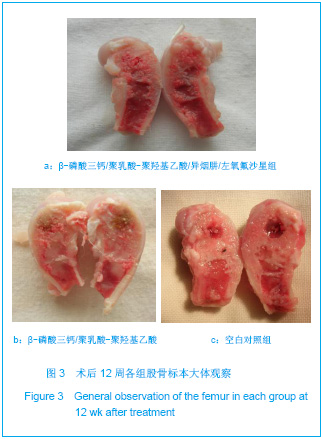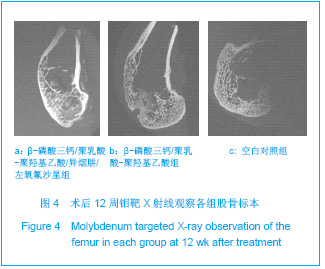| [1] Wan LL,Liu HW.Kouqiang Yixue Yanjiu.2010;26(4): 497-500. 万蕾蕾,刘宏伟.β-磷酸三钙复合骨髓基质细胞构建组织工程骨的实验研究[J].口腔医学研究,2010,26(4): 497-500.[2] Wang Z,Guo Z,Li J,et al.Zhonghu Guke Zazhi.2011; 31(6): 564-570. 王臻,郭征,李靖,等.多孔磷酸三钙人工骨修复腔隙性骨缺损的随机对照研究[J].中华骨科杂志,2011,31(6): 564-570.[3] Fang Z,Yang Q,Xiong W,et al.Zhonghua Shiyan Waike Zazhi. 2011;28(7): 1033-1035. 方忠,杨琴,熊伟,等.腺病毒介导转染人生长转化因子β1的脂肪干细胞复合多孔β-磷酸三钙支架体外培养的研究[J].中华实验外科杂志,2011,28(7):1033-1035.[4] Chen YF,Wang L,Zhang Y,et al.Shengwu Guke Cailiao Yu Linchuang Yanjiu. 2012; 9(1): 8-12. 陈永锋,王林,张扬,等.以β-磷酸三钙为支架组织工程骨在兔脊柱后外侧融合中的作用研究[J].生物骨科材料与临床研究,2012, 9(1):8-12.[5] Zhe SL.Zuzhi Gongcheng yu Chongjian Waike Zazhi. 2011; 7(4): 235-237. 折胜利.PLA/PLGA共聚物在组织工程中的应用[J].组织工程与重建外科杂志, 2011,7(4):235-237.[6] Zhao XJ,Qi XS,Dong YS. Guoji Shengwu Yixue Gongcheng Zazhi.2010; 33(3):147-151. 赵锡江,齐新生,董寅生. rhBMP-2/PLGA缓释支架的制备及对MSCs细胞成骨活性的体外研究[J].国际生物医学工程杂志, 2010,33(3):147-151.[7] Hao W,Jiang M,Wang X,et al.Zhonghua Shiyan Waike Zazhi.2011; 28(9): 1547-1549. 郝伟,姜明,王新,等. Ⅰ型胶原凝胶包埋脂肪干细胞复合PLGA-β-TCP支架修复兔自体桡骨缺损[J].中华实验外科杂志,2011,28(9): 1547-1549.[8] Ma YZ.Zhongguo Jizhu Jisui Zazhi.2010;20 (10):795-796. 马远征.进一步提高脊柱结核的治疗效果[J].中国脊柱脊髓杂志,2010,20(10):795-796.[9] Cui X,Ma YZ,Chen X,et al.Jizhu Jisui Zazi.2011; 21(10): 807-812. 崔旭,马远征,陈兴,等.不同手术方法治疗脊柱结核及其疗效分析[J].中国脊柱脊髓杂志,2011,21(10):807-812.[10] Ma Y,Cui X,Li H,et al.The outcome of anterior or posterior instrumentation under different surgical procedure in the treatment of thoracic and lumbar spinal tuberculosis in adults. Int Orthop.2012;36(2):299-305.[11] Peltier LF,Jones RH.Treatment of unicameral bone cysts by curettage and packing with plaster of Paris pellets. J Bone Joint Surg Am.1978;60:820-822.[12] Hu Y,Ma Y,He HY.Zhongguo Zuzhi Gongcheng Yanjiu yu Linchuang Kangfu. 2011;15(16): 2905-2910. 胡杨,马莹,何惠宇.β-磷酸三钙支架材料即刻植入对保存剩余牙槽嵴的影响[J].中国组织工程研究与临床康复,2011,15(16): 2905-2910.[13] Zhao L,He CG,Gao YJ,et al.Zhongguo Shengwu Gongcheng Zazhi.2008;28(5):22-28. 赵莉,何晨光,高永娟,等.PLGA的不同组成对支架材料性能的影响研究[J].中国生物工程杂志,2008,28(5):22-28.[14] Yang F,Cui W,Wang S,et al.Poly(L-lactide-co-glycolide) tricalcium phosphate composite scaffold and its various changes during degradation in vitro. Polym Degrad Stab.2006; 91:3065-3073.[15] Kobayashi S,Sakamoto K.Effect of hydrolysis on mechanical properties of tricalcium phosphate/poly-L: -lactide composites.J Mater Sci Mater Med.2009;20(1):379-386.[16] Zhang N,Lang X,Li XY,et al.Xiyou Jinshu Cailiao yu Gongcheng. 2008; 37(1):702-705. 张宁,梁星,李小玉,等.新型聚乳酸/β-磷酸三钙(PLLA/β-TCP)多孔支架材料的性能分析[J].稀有金属材料与工程,2008,37(1): 702-705.[17] Sun L,Xiong Z Zhongguo Zuzhi Gongcheng Yanjiu yu Linchuang Kangfu.2011;15(12):2091-2094. 孙梁,熊卓.快速成型聚乳酸-聚羟乙酸/磷酸三钙支架修复兔桡骨缺损[J].中国组织工程研究与临床康复,2011,15(12): 2091-2094.[18] Wang X,Liu YJ,Chen X.Zhongguo Zuzhi Gongcheng Yanjiu yu Linchuang Kangfu. 2011,15(21): 3807-3180. 王晓,刘玉杰,陈 旭.β-磷酸三钙/聚-L-乳酸复合材料的骨内降解[J].中国组织工程研究与临床康复,2011,15(21): 3807-3180. [19] Chen X,Bao D,Ma YZ,et al.Jizhu Waike Zazhi.2008;6(5): 284-286. 陈兴,鲍达,马远征,等.颈椎结核耐药性观察及个体化治疗[J].脊柱外科杂志, 2008,6(5): 284-286.[20] Yu FY,Ma YZ,Li HW.Zhonghua Waike Zazhi.2008;46(9): 641-642. 余方圆,马远征,李宏伟.重视非典型脊柱结核的诊断与鉴别诊断[J].中华外科杂志,2008,46(9):641-642. |



.jpg)
.jpg)